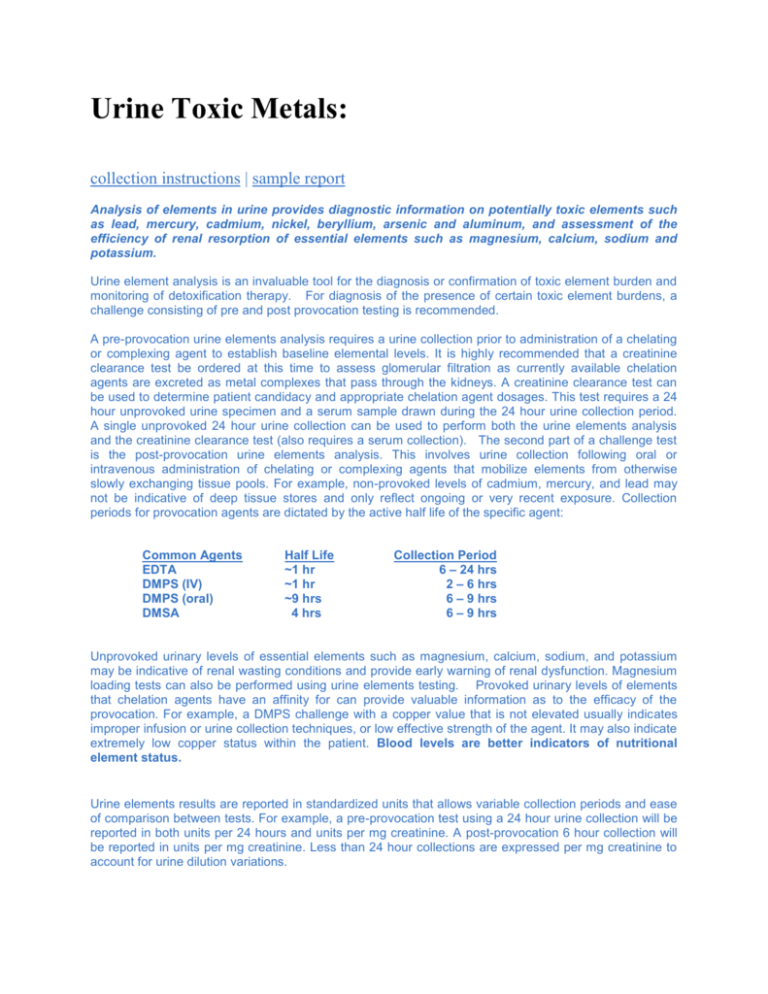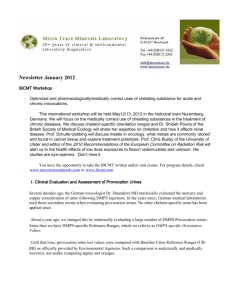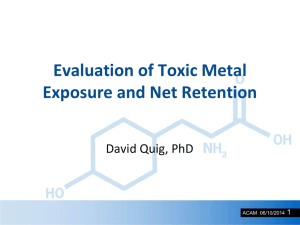Doctors Data Urine Toxic Metals
advertisement

Urine Toxic Metals: collection instructions | sample report Analysis of elements in urine provides diagnostic information on potentially toxic elements such as lead, mercury, cadmium, nickel, beryllium, arsenic and aluminum, and assessment of the efficiency of renal resorption of essential elements such as magnesium, calcium, sodium and potassium. Urine element analysis is an invaluable tool for the diagnosis or confirmation of toxic element burden and monitoring of detoxification therapy. For diagnosis of the presence of certain toxic element burdens, a challenge consisting of pre and post provocation testing is recommended. A pre-provocation urine elements analysis requires a urine collection prior to administration of a chelating or complexing agent to establish baseline elemental levels. It is highly recommended that a creatinine clearance test be ordered at this time to assess glomerular filtration as currently available chelation agents are excreted as metal complexes that pass through the kidneys. A creatinine clearance test can be used to determine patient candidacy and appropriate chelation agent dosages. This test requires a 24 hour unprovoked urine specimen and a serum sample drawn during the 24 hour urine collection period. A single unprovoked 24 hour urine collection can be used to perform both the urine elements analysis and the creatinine clearance test (also requires a serum collection). The second part of a challenge test is the post-provocation urine elements analysis. This involves urine collection following oral or intravenous administration of chelating or complexing agents that mobilize elements from otherwise slowly exchanging tissue pools. For example, non-provoked levels of cadmium, mercury, and lead may not be indicative of deep tissue stores and only reflect ongoing or very recent exposure. Collection periods for provocation agents are dictated by the active half life of the specific agent: Common Agents EDTA DMPS (IV) DMPS (oral) DMSA Half Life ~1 hr ~1 hr ~9 hrs 4 hrs Collection Period 6 – 24 hrs 2 – 6 hrs 6 – 9 hrs 6 – 9 hrs Unprovoked urinary levels of essential elements such as magnesium, calcium, sodium, and potassium may be indicative of renal wasting conditions and provide early warning of renal dysfunction. Magnesium loading tests can also be performed using urine elements testing. Provoked urinary levels of elements that chelation agents have an affinity for can provide valuable information as to the efficacy of the provocation. For example, a DMPS challenge with a copper value that is not elevated usually indicates improper infusion or urine collection techniques, or low effective strength of the agent. It may also indicate extremely low copper status within the patient. Blood levels are better indicators of nutritional element status. Urine elements results are reported in standardized units that allows variable collection periods and ease of comparison between tests. For example, a pre-provocation test using a 24 hour urine collection will be reported in both units per 24 hours and units per mg creatinine. A post-provocation 6 hour collection will be reported in units per mg creatinine. Less than 24 hour collections are expressed per mg creatinine to account for urine dilution variations.









